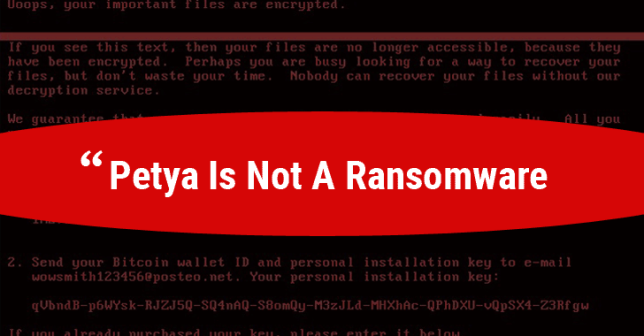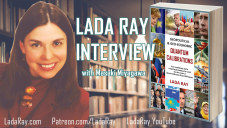What if I say the Tuesday’s devastating global malware outbreak was not due to any ransomware infection?
Yes, the Petya ransomware attacks that began infecting computers in several countries, including Russia, Ukraine, France, India and the United States on Tuesday and demands $300 ransom was not designed with the intention of restoring the computers at all.
According to a new analysis, the virus was designed to look like ransomware but was wiper malware that wipes computers outright, destroying all records from the targeted systems.
Comae Technologies Founder Matt Suiche, who closely looked the operation of the malware, said after analyzing the virus, known as Petya, his team found that it was a “Wiper malware,” not ransomware.
Security experts even believe the real attack has been disguised to divert world’s attention from a state-sponsored attack on Ukraine to a malware outbreak.
“We believe the ransomware was, in fact, a lure to control the media narrative, especially after the WannaCry incident, to attract the attention on some mysterious hacker group rather than a national state attacker,” Suiche writes.
Is Petya Ransomware Faulty or Over-Smart?
Petya is a nasty piece of malware that, unlike other traditional ransomware, does not encrypt files on a targeted system one by one.
Instead, Petya reboots victims computers and encrypts the hard drive’s master file table (MFT) and renders the master boot record (MBR) inoperable, restricting access to the full system by seizing information about file names, sizes, and location on the physical disk.
Then Petya ransomware takes an encrypted copy of MBR and replaces it with its own malicious code that displays a ransom note, leaving computers unable to boot.
However, this new variant of Petya does not keep a copy of replaced MBR, mistakenly or purposely, leaving infected computers unbootable even if victims get the decryption keys.
Also, after infecting one machine, the Petya ransomware scans the local network and quickly infects all other machines (even fully-patched) on the same network, using EternalBlue SMB exploit, WMIC and PSEXEC tools.
Don’t Pay Ransom; You Wouldn’t Get Your Files Back
So far, nearly 45 victims have already paid total $10,500 in Bitcoins in hope to get their locked files back, but unfortunately, they would not.
Meaning, even if victims do pay the ransom, they will never recover their files. Kaspersky researchers also said same.
“Our analysis indicates there is little hope for victims to recover their data. We have analyzed the high-level code of the encryption routine, and we have figured out that after disk encryption, the threat actor could not decrypt victims’ disks,” the security firm said.
“To decrypt a victim’s disk threat actors need the installation ID. In previous versions of ‘similar’ ransomware like Petya/Mischa/GoldenEye this installation ID contained the information necessary for key recovery.”
If claims made by the researcher is correct that the new variant of Petya is a destructive malware designed to shut down and disrupt services around the world, the malware has successfully done its job.
However, it is still speculation, but the virus primarily and massively targeted multiple entities in Ukraine, including the country’s local metro, Kiev’s Boryspil airport, electricity supplier, the central bank, and the state telecom.
Other countries infected by the Petya virus included Russia, France, Spain, India, China, the United States, Brazil, Chile, Argentina, Turkey and South Korea.
How Did Petya get into the Computers in the First Place?
According to research conducted by Talos Intelligence, little-known Ukrainian firm MeDoc is likely the primary source of the yesterday’s global ransomware outbreak.
Researchers said the virus has possibly been spread through a malicious software update to a Ukrainian tax accounting system called MeDoc, though MeDoc has denied the allegations in a lengthy Facebook post.
“At the time of updating the program, the system could not be infected with the virus directly from the update file,” translated version of MeDoc post reads. “We can argue that users of the MEDoc system can not infect their PC with viruses at the time of updating the program.”
However, several security researchers and even Microsoft agreed with Talo’s finding, saying MeDoc was breached and the virus was spread via updates.






























Lada:
I’m surprised you indicate that these attacks might be part of a 4D effort by the NWO cabal. I thought they were strictly low-vibration, lower 3D. Interested to hear more. Why did Putin meet with the Ethereum creator not long ago? Does that have some bearing on these state-sponsored attacks?
LikeLike
As I said, I’ll reveal all that in ESW3 The Future of Money, incl Bitcoin and Ethereum.
LikeLike
Well done noting the news of Putin’s meeting with the developer behind Ethereum. Many would have seen it as an inconsequential sideline event, but it appears that Russia is starting to seriously look into the digital currency, with support voiced even by German Gref.
One thing that is worth mentioning about Ethereum: it is much more than just another digital currency. True, Ether is a payment method for the operations conducted on the Ethereum network, but the network protocol itself is an innovative blockchain-based system that allows for development of decentralised, provably fair (ones that cannot be tempered with) applications. This opens up for a whole new dimension of direct democracy – for example referendums or, ultimately – presidential elections, run on the Ethereum network, fully cryptographically protected against any manipulations, fraud and tempering!
LikeLike
Nemo, I know you are a big supporter of crypto-currencies, and that’s great, but let’s not get carried away.
I’ll talk about how I see the full picture in The Future of Money, incl why Putin met Vitalik.
Incidentally, the fact that German Gref supports something is more of an indictment in Russia, than a compliment, didn’t you know? Gref is considered a direct agent of the global banksters.
More during webinar. If you have any questions on this, I can answer them during the webinar too.
LikeLike
You are right, Lada. I can get a bit carried away when it comes to innovative technologies. 🙂
I do, indeed, know about Gref and his connection to the Bank of Russia, with all that it in turn implies (I am sure you are going to touch upon it in the Webinar), so a few warning bells did ring while I was typing that yesterday. However, seeing that Bank of Russia was initially opposed to Bitcoin, almost criminalising its use, while they are at least considering it now, I thought that this act was a kind of concession on the globalist part.
LikeLike
As usual, the best defence is being prepared. Viruses infecting MBR are as old as DOS system… The best defence is to either have a backup of MBR or, better still, to have off-line backups of both your data and system. I could recommend the German O&O DiskImage which I’ve been using for years – take an image of your entire system partition/disk and keep it on an off-line disk. Add new back-ups as time passes. If you get infected, simply, restore to an older backup, booting from a recovery DVD or a memory stick.
LikeLiked by 1 person
Heads up: There may be a pending chemical false flag in Syria that US will use as a pretext for more strikes or an outright invasion. I want to reference the following article at Russia Insider:
http://russia-insider.com/en/politics/us-military-put-alert-washington-waiting-excuse-attack-syria-russian-senator/ri20238
Russia Insider is crowd-funded cooperative of investigative journalists and analysts from many parts of the world, who did not want to play the MSM game. I know that on at least one occasion RT referenced their report in their article. I’ve been following their publications for over a year now, occasionally supporting them with donations, and can vouch for the quality of their reporting (though an occasional article can a be a tad tongue-in-cheek sarcastic).
LikeLike
PS: Looks like my previous heads-up about a false flag is a little too late:
http://russia-insider.com/en/politics/it-begins-islamist-rebels-accuse-syrian-army-chlorine-attack/ri20248
LikeLike